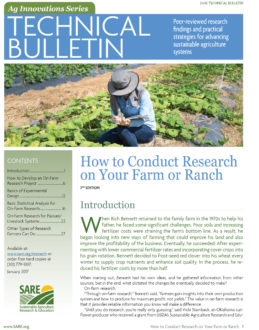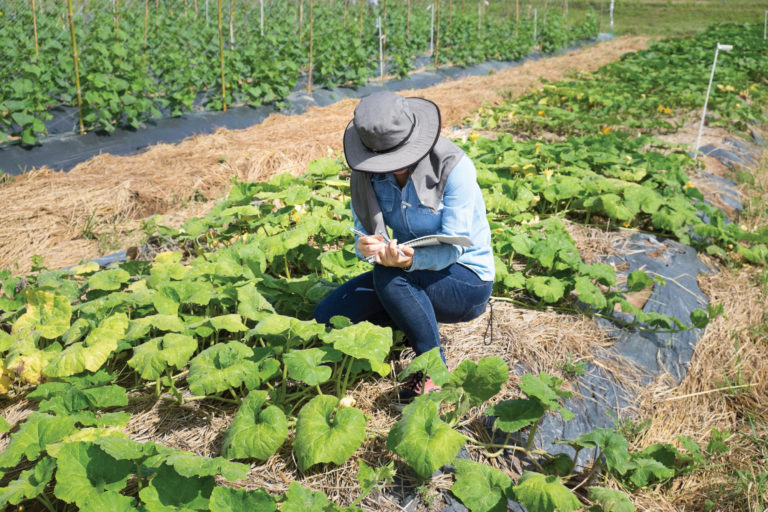When Rich Bennett returned to the family farm in the 1970s to help his father, he faced some significant challenges. Poor soils and increasing fertilizer costs were straining the farm’s bottom line. As a result, he began looking into new ways of farming that could improve his land and also improve the profitability of the business. Eventually, he succeeded: After experimenting with lower commercial fertilizer rates and incorporating cover crops into his grain rotation, Bennett decided to frost-seed red clover into his wheat every winter to supply crop nutrients and enhance soil quality. In the process, he reduced his fertilizer costs by more than half.
When starting out, Bennett had his own ideas, and he gathered information from other sources, but in the end, what dictated the changes he eventually decided to make?
On-farm research.
“Through on-farm research,” Bennett said, “farmers gain insights into their own production system and how to produce for maximum profit, not yields.” The value in on-farm research is that it provides reliable information you know will make a difference.
“Until you do research, you’re really only guessing,” said Vicki Stamback, an Oklahoma cut-flower producer who received a grant from USDA’s Sustainable Agriculture Research and Education (SARE) program to test greenhouse efficiency. “When you have the numbers in front of you, you know.” After two years of experimenting with different greenhouse temperatures, Stamback determined the minimum temperature required to raise flowers in the winter most cost effectively. While most flower producers run their greenhouses at about 65 degrees, setting the thermostat as low as 45 degrees for flowers like ranunculus, sweet peas, lupine and fresia dramatically reduced Stamback’s greenhouse heating bill. Moreover, she discovered that she could grow flowers like delphinium, larkspur and snapdragons without any supplemental heat. After performing the research, Stamback said she now “knows the best temperature to use, plus what crops to grow to make the most profit.”
In on-farm research, farmers and ranchers conduct or help conduct the experiment, providing a real-life setting in which to test their theories. This publication will help you learn more about on-farm research. It will introduce you to the purpose and goals of on-farm research and show you how on-farm research works on real farms. If you are exploring on-farm research for the first time and just want to get an idea of what is involved, this publication will introduce you to the basic steps. If you are ready to plan and implement your project, this publication provides more specific information on experimental design, and how to lay out your field plots and analyze your data using basic statistical techniques. The focus is on-farm research for cropping systems, but some techniques for livestock and pasture-based systems are highlighted. We hope this publication will inspire you to go further in experimenting with new ideas on your farm.
Systems Research Versus On-Farm Research
Although farms and ranches are complex “systems,” when you conduct on-farm research you will most likely be following a “reductionist” approach because you will be isolating a certain part of a whole farming system in order to explain how that part works or responds to certain changes.
Due to the sheer size and complexity of whole-systems research, it would be impossible for you to conduct this type of research on your farm. Systems research projects are usually large scale, take place over many years or even decades, and often involve researchers from multiple disciplines.
However, throughout your research—from developing your question to analyzing and interpreting the results—try to maintain a broad perspective on the systems aspect of your farm. Note how changing one aspect of your system affects other parts. For example, if you were to study the effects of a cover crop on soil organic matter or soil nitrogen levels and found that the cover crop conferred some benefits to the soil, consider how adding this cover crop might impact your entire rotation, and, what other changes you might have to make to compensate for adding a new crop into the rotation.
To learn more about systems research, see the SARE book, Systems Research for Agriculture, as well as other information listed in the Resources section.
This bulletin was written by David Chaney, DEC Education Services, based on the first edition (2000) that was written by Valerie Berton (SARE), Dan Anderson (University of Illinois), Mark Honeyman (Iowa State University) and John Luna (Oregon State University). Sections of this edition were adapted from similar work by Keith Baldwin (North Carolina A&T State University) and SARE grantees Bridgett Hilshey, Sidney Bosworth and Rachel Gilker (University of Vermont). Contributors include Andy Clark (SARE), Diana Friedman (SARE) and Cary Rivard (Kansas State University).
This publication was developed by the Sustainable Agriculture Research and Education (SARE) program with funding from National Institute of Food and Agriculture, USDA. Any opinions, findings, conclusions or recommendations expressed here do not necessarily reflect the view of the U.S. Department of Agriculture.

